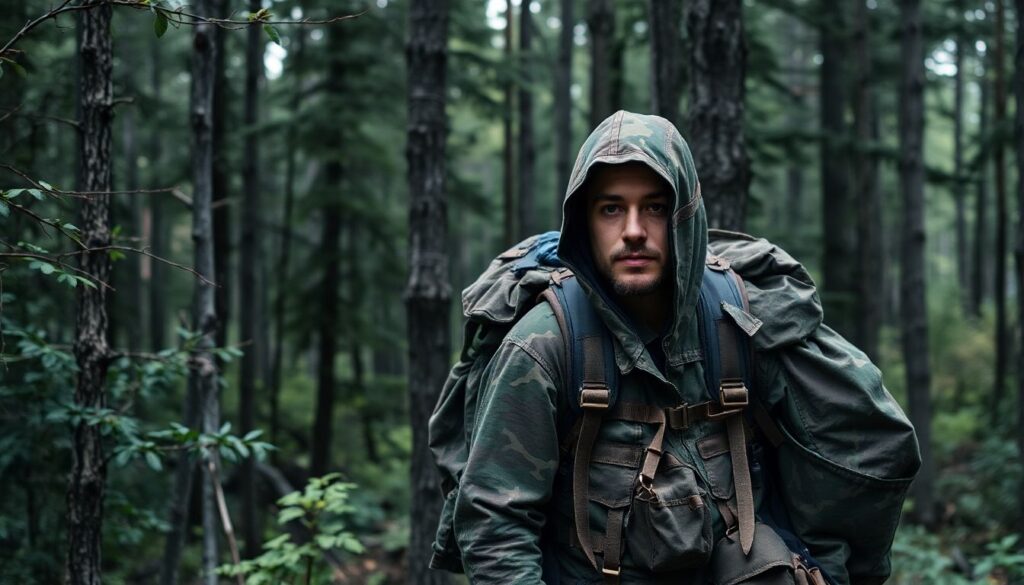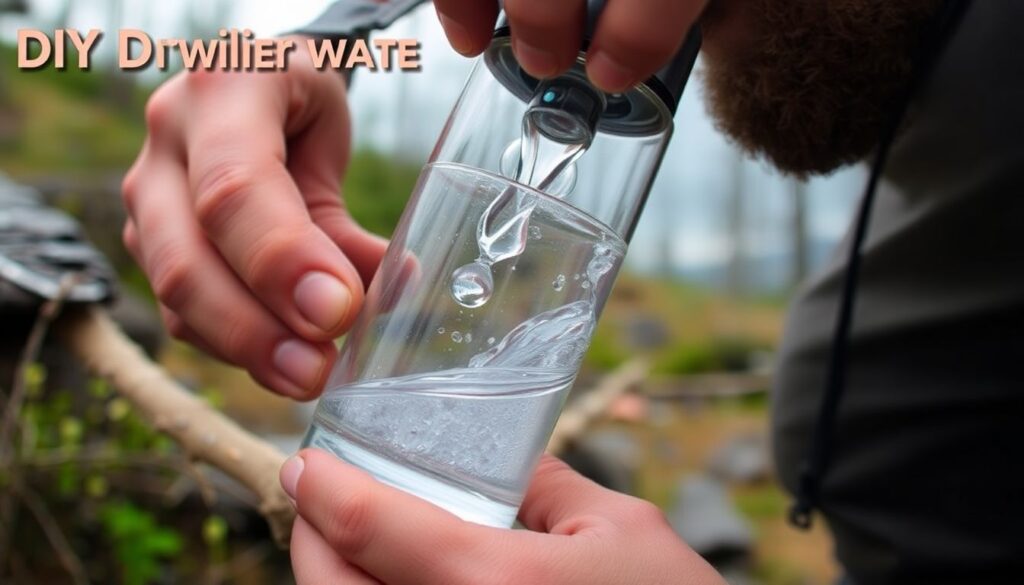Have you ever wondered how some animals, like the chameleon, can seemingly disappear into their surroundings, or how special forces soldiers can move undetected through enemy territory? The art of DIY camouflage and stealth techniques is not just reserved for the animal kingdom or elite military units; it’s a crucial skill that can mean the difference between life and death in survival situations. But how does one achieve this level of concealment? And why is it so important in survival scenarios? Let’s delve into the fascinating world of DIY camouflage and explore how you can use these techniques to blend in and stay alive when it matters most.
First, let’s address the elephant in the room: why is camouflage so important in survival situations? According to a study by the U.S. Army, up to 90% of a soldier’s ability to avoid detection is due to their camouflage. In a survival context, this means that your ability to blend into your environment could significantly increase your chances of avoiding dangerous situations, from encounters with wild animals to potential threats from other humans. But what if you don’t have access to military-grade camouflage gear? Fear not, for the power of DIY camouflage is within your reach.
In this article, we promise to take you on a comprehensive journey into the world of DIY camouflage and stealth techniques. We’ll start by exploring the science behind camouflage, delving into the fascinating world of color theory and how it applies to survival situations. We’ll then provide you with a step-by-step guide on how to create your own camouflage using natural materials, ensuring that you’re well-equipped to blend into any environment. But we won’t stop there. We’ll also explore advanced stealth techniques, from how to move silently through the wilderness to how to create effective hiding spots. By the end of this article, you’ll have a comprehensive understanding of DIY camouflage and the confidence to put these techniques into practice in real-life survival situations.
So, whether you’re a seasoned survivalist looking to expand your skillset or a curious individual eager to learn more about the art of concealment, this article is for you. So, buckle up and get ready to become one with your surroundings, for we are about to embark on an adventure that could just save your life.
Mastering the Art of Invisibility: DIY Camouflage Techniques for Survival
In the grand theater of nature, the art of invisibility is a performance as old as time itself, mastered by countless creatures for survival. From the chameleon’s color-shifting dance to the octopus’s mesmerizing mimicry, the ability to blend into one’s surroundings is a crucial skill that has evolved to ensure survival. In the human realm, this art takes the form of camouflage, a technique that has been honed by soldiers, hunters, and outdoor enthusiasts alike. Mastering the art of invisibility is not just about wearing the right colors or patterns; it’s about understanding light, shadow, and the science behind perception. It’s about becoming one with your environment, anticipating the eye’s movement, and manipulating the viewer’s focus. In this exploration, we’ll delve into the world of DIY camouflage, uncovering techniques that transform you from a conspicuous figure to an almost imperceptible presence. We’ll explore the science behind camouflage patterns, the art of face painting, and the strategic use of natural materials. We’ll learn how to harness the power of shadows, how to blend into various terrains, and how to create our own camouflage gear. So, whether you’re a survivalist preparing for the unknown, a hunter seeking the perfect shot, or simply a curious mind eager to master a new skill, join us as we embark on this fascinating journey into the world of DIY camouflage.

Understanding Camouflage: The Science Behind Blending In
Camouflage, an ingenious strategy employed by both nature and mankind, is a fascinating blend of art and science. At its core, camouflage is about manipulating an observer’s perception, making an object blend seamlessly into its surroundings. This is achieved through several key principles, each a testament to the intricate dance between form and function. The first principle, disruptive coloration, is a masterclass in misdirection. Imagine a giraffe’s coat, a symphony of brown patches on a yellow background. These patches, when viewed up close, seem chaotic, but from a distance, they break up the giraffe’s outline, making it harder for predators to distinguish it from the savannah. In the man-made world, this principle is evident in the digital camouflage patterns used by modern militaries, where irregular shapes and colors disrupt the soldier’s outline, making them less visible to the human eye and even more so to thermal imaging devices. Countershading, another powerful tool in the camouflage arsenal, is a response to the way light interacts with objects. When light hits an object, it’s scattered in all directions, but the intensity of this scattering varies depending on the angle. As a result, objects tend to appear lighter on their upper surfaces and darker on their lower surfaces. Countershading plays on this phenomenon. A great example is the white belly and dark back of a polar bear. Against the snow and ice, the bear’s belly reflects the bright surroundings, while its back absorbs the light, making it nearly invisible. In military applications, this principle is seen in the use of light colors on the top of vehicles and dark colors on the bottom, helping them blend into their surroundings from different angles. Background matching, the third principle, is about mimicking the environment as closely as possible. Consider the octopus, a master of disguise, capable of changing its skin color, pattern, and even texture to match its surroundings. In the human world, this principle is evident in the use of net-like camouflage netting that mimics the dappled light and shadows of a forest canopy, providing soldiers with a degree of concealment. These principles, when used individually or in combination, create a powerful toolkit for blending in. Whether it’s a chameleon changing color to match its surroundings, a soldier donning a ghillie suit to blend into the landscape, or a stealth aircraft using a combination of these principles to evade radar detection, the science of camouflage is a testament to the ingenuity of both nature and mankind.
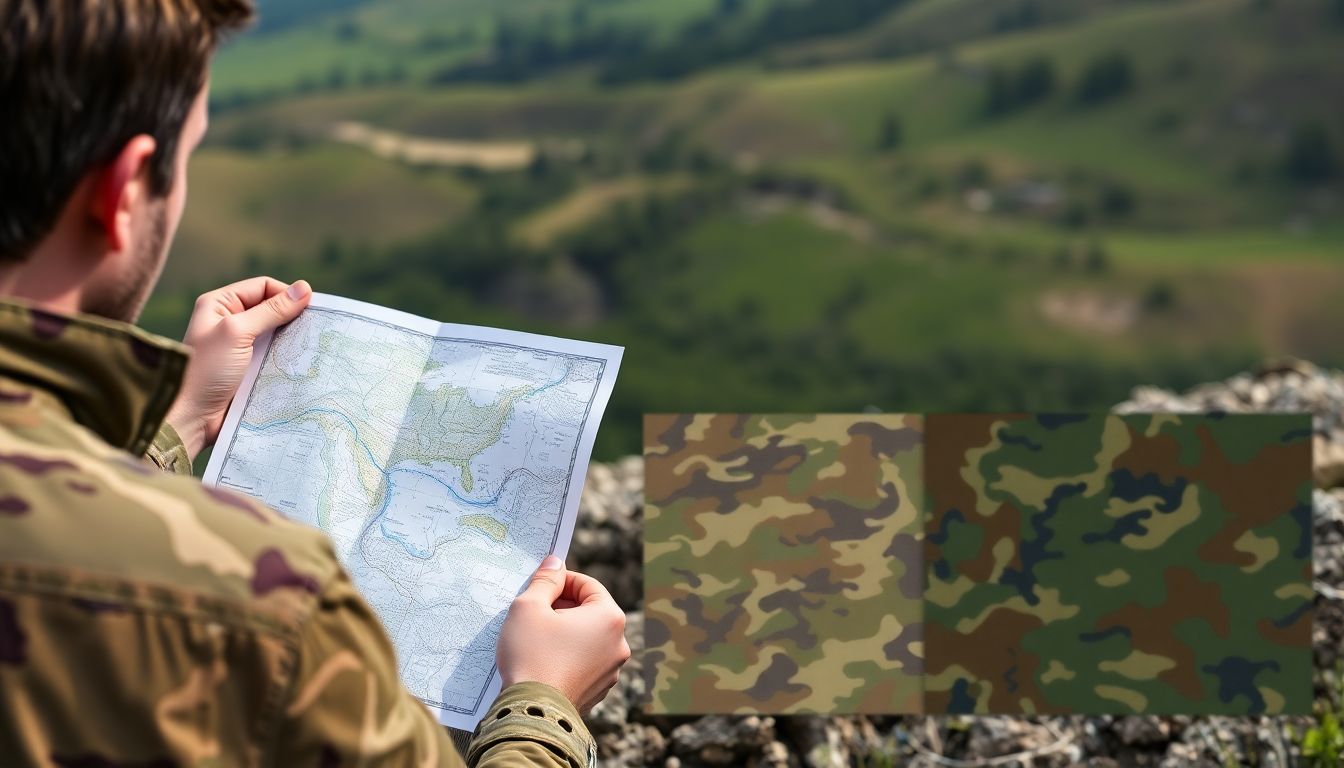
Assessing Your Environment: Choosing the Right Camouflage
When it comes to blending into your environment, the key lies in understanding and analyzing your surroundings. The first step is to observe the lighting conditions. Is it bright and sunny, or dim and overcast? The amount of light can significantly impact the visibility of your outline and the contrast between you and your background. In bright sunlight, you’ll want to opt for lighter, more muted colors to avoid creating stark shadows. Conversely, in low light or at night, darker colors will help you blend in.
Next, consider the season. In autumn, the vibrant reds, oranges, and browns of falling leaves can provide excellent camouflage. In winter, the stark whites and grays of snow-covered landscapes call for a different approach. During spring and summer, the lush greens of foliage and the vibrant colors of flowers can help you blend in.
The terrain is another crucial factor. If you’re in a forest, the dappled light and varied shades of green suggest a pattern like camouflage fatigues. In a desert, the sandy hues and lack of vegetation point to earthy tones and subtle patterns. In a snowy landscape, white with subtle gray or blue undertones can help you disappear.
Lastly, observe the wildlife. Animals have evolved excellent camouflage strategies, and mimicking their colors and patterns can help you blend in. For instance, in a grassy field, the browns and greens of deer can provide inspiration.
In conclusion, choosing the right camouflage is not just about wearing the right colors, but also understanding and adapting to your environment. By analyzing the light, season, terrain, and even the local wildlife, you can make an informed decision that will help you blend in and become one with your surroundings.

DIY Camouflage Fabrics: Transforming Ordinary Clothes
Transforming ordinary clothes into effective camouflage can be a fun and rewarding DIY project. With a little creativity and some readily available materials, you can create your own unique camouflage patterns that blend seamlessly with your surroundings. The key to successful camouflage is to mimic the colors, textures, and patterns found in nature. In this guide, we’ll explore how to use natural dyes, fabric paints, and other materials to create your own camouflage fabrics.
The first step in creating your own camouflage is to gather your materials. You’ll need a variety of natural dyes, such as coffee, tea, or turmeric, to create different shades of brown, green, and other earthy tones. Fabric paints in similar shades can also be used to add details and patterns. Additionally, you’ll need some old clothes or fabric scraps to practice on before attempting to transform your favorite garments.
Once you have your materials, it’s time to start dyeing. To create a natural dye, simply steep the desired plant material in hot water for several hours, then strain the liquid into a large pot. Add your fabric to the pot, making sure it’s completely submerged, and let it soak in the dye bath until it reaches your desired shade. Keep in mind that the longer the fabric soaks, the darker the color will become.
After dyeing, it’s time to add patterns and details. Using fabric paints, you can create leaves, branches, or other natural elements that will help your camouflage blend in with its surroundings. To create a realistic effect, use a variety of shades and sizes, and don’t be afraid to get creative!
Here are some tips for achieving the best results:
- Use a variety of shades and patterns to create depth and realism.
- Consider the environment you’ll be using your camouflage in, and try to mimic the colors and patterns found there.
- Practice on scrap fabric before attempting to transform your favorite clothes.
- Allow your fabric to dry completely between dyeing and painting to prevent bleeding.
With a little patience and creativity, you can transform ordinary clothes into effective camouflage that’s perfect for hiking, hunting, or just having fun in the great outdoors. So grab your materials and get started – the possibilities are endless!

Face and Hands: The Tell-Tale Signs of Human Presence
In the grand theater of human interaction, the face and hands often steal the spotlight, serving as the most expressive and revealing parts of our anatomy. They are the most challenging to conceal, not only because they are constantly in motion but also due to their unique textures and colors that starkly contrast with our surroundings. The face, with its intricate network of muscles, is a masterpiece of emotion, while the hands, with their dexterity and versatility, are the tools of our trade and the extensions of our expressions.
To effectively camouflage these tell-tale signs of human presence, one must first understand the principles of camouflage. The goal is not to make the face and hands disappear entirely, but to blend them into the environment, making them less noticeable. This can be achieved through a combination of natural materials, makeup, and other methods.
Let’s start with natural materials. Mud, charcoal, and plant pigments can be used to alter the color and texture of the skin, helping it blend with the surroundings. For instance, in a forest environment, applying a mixture of mud and green plant pigments can help break up the outline of the face and hands, making them less visible. Similarly, in a desert setting, a mixture of sand and ochre can help mimic the color and texture of the sand.
Makeup, when used creatively, can also be a powerful tool for camouflage. Foundation, concealer, and contouring techniques can be used to alter the shape and color of the face and hands, helping them blend into the environment. For example, using a darker shade of foundation on the sides of the face and a lighter shade on the forehead and chin can help create the illusion of shadows, making the face less visible. Similarly, using a green or brown eyeshadow can help blend the hands into a forest or desert environment.
Other methods of camouflage include the use of face and hand masks, gloves, and even temporary tattoos. These can help alter the shape and color of the face and hands, making them less recognizable. However, it’s important to note that these methods should be used sparingly, as they can also draw attention to the face and hands if not used correctly.
In conclusion, while the face and hands are the most challenging parts of the body to conceal, they are not impossible to camouflage. With a little creativity and the right materials, one can effectively blend these tell-tale signs of human presence into the environment, making them less noticeable to the untrained eye.
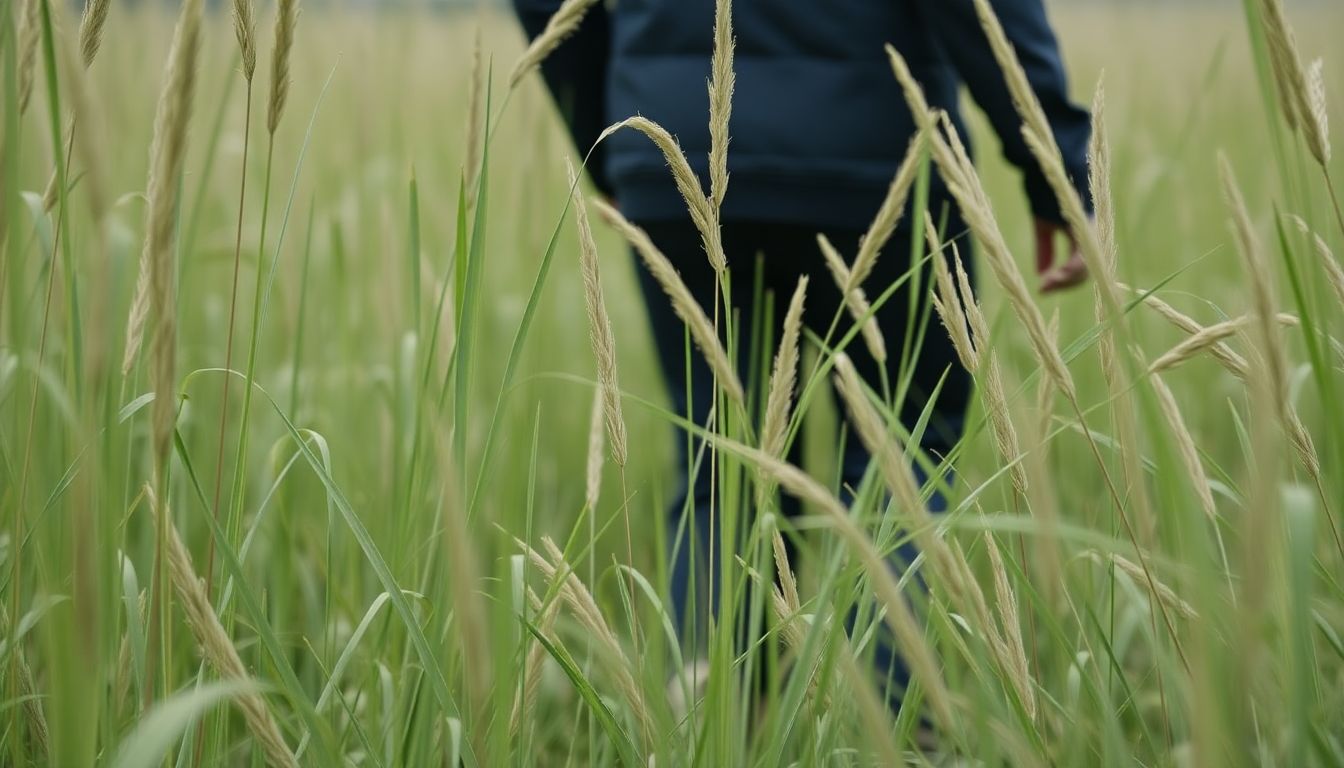
Stealth Movement: How to Move Silently Through Your Environment
Stealth movement, the art of traversing your environment silently, is not just a skill reserved for espionage thrillers or video games. It’s a crucial ability that can help you maintain concealment, avoid unwanted attention, or simply enjoy nature without disturbing its harmony. The importance of stealth movement lies in its ability to keep you hidden, safe, and undetected, whether you’re navigating a dense forest, a bustling city, or a quiet suburban neighborhood.
Mastering stealth movement begins with understanding your environment. Observe the terrain, the wind direction, and the potential obstacles. A stealthy approach requires careful planning and anticipation. Remember, the goal is not just to move quietly, but to avoid detection altogether.
Now, let’s delve into the techniques of stealth movement. The key lies in minimizing noise and maintaining balance.
- Walking: The heel-to-toe method is your best friend here. Start with your heel, then roll your foot forward, ending with your toes. This distributes your weight evenly, reducing the impact and noise. Keep your steps small and controlled. Avoid stomping or dragging your feet.
- Running: If you need to cover distance quickly and quietly, a bounding technique can be useful. Instead of lifting your feet, push off with your toes, then land softly on the balls of your feet. Keep your strides short and your knees high to maintain balance and control.
- Navigating Different Terrains:
- Grass: Walk sideways or use a zigzag pattern to distribute your weight and avoid leaving visible tracks.
- Snow: Use snowshoes or skis to distribute your weight and prevent sinking.
- Leaves or Dry Leaves: Stick to paths or use a pole to test the ground ahead. If you must cross, do so quickly and quietly.
- Rocks: Test each step before committing your full weight. Use handholds for balance and to distribute your weight.
Practice makes perfect in stealth movement. Spend time in different environments, honing your skills, and learning from your mistakes. Remember, the goal is not to be completely silent, but to be silent enough to avoid detection. So, go ahead, become one with the shadows, and master the art of stealth movement.

Camouflaging Your Gear: Extending Your Invisibility
In the art of survival and stealth, the ability to blend in with your environment is paramount. This extends not just to your clothing, but also to your gear. Camouflaging your equipment ensures you remain undetected, whether you’re hunting, hiking, or navigating a survival scenario. Let’s explore how to make your gear as invisible as you are.
The first step is to understand your surroundings. Different environments require different camouflage. For instance, in a forest, earthy greens and browns dominate, while in a desert, sandy beiges and tans are key.
Start with your backpack, your most visible piece of gear. If it’s a solid color, consider covering it with a camouflage cover or a poncho in a suitable color. You can also use camouflage tape or spray paint to break up its shape and color. Remember, the goal is to disrupt the outline and color, making it harder for the eye to pick out.
Water bottles are another giveaway. They’re often bright and reflective. Wrap them in camouflage tape or a sock to dull their shine and change their color. You can also use a bandana or a piece of clothing to cover them when not in use.
Other essential items like cooking pots, knives, and tools should also be considered. For metal items, use a cloth or a piece of tape to dull their shine. For non-metal items, consider covering them with a piece of cloth or a sock in a suitable color.
Don’t forget about your gear’s reflectivity. Many items have reflective surfaces that can give you away, even in low light. Use a cloth or a piece of tape to dull these surfaces.
Finally, consider your gear’s placement. Don’t leave it lying around. Keep it close to you and try to position it in a way that blends in with its surroundings.
In conclusion, camouflaging your gear is a crucial skill that can significantly enhance your stealth and survival capabilities. It’s not just about what you wear, but also about what you carry and how you use it.
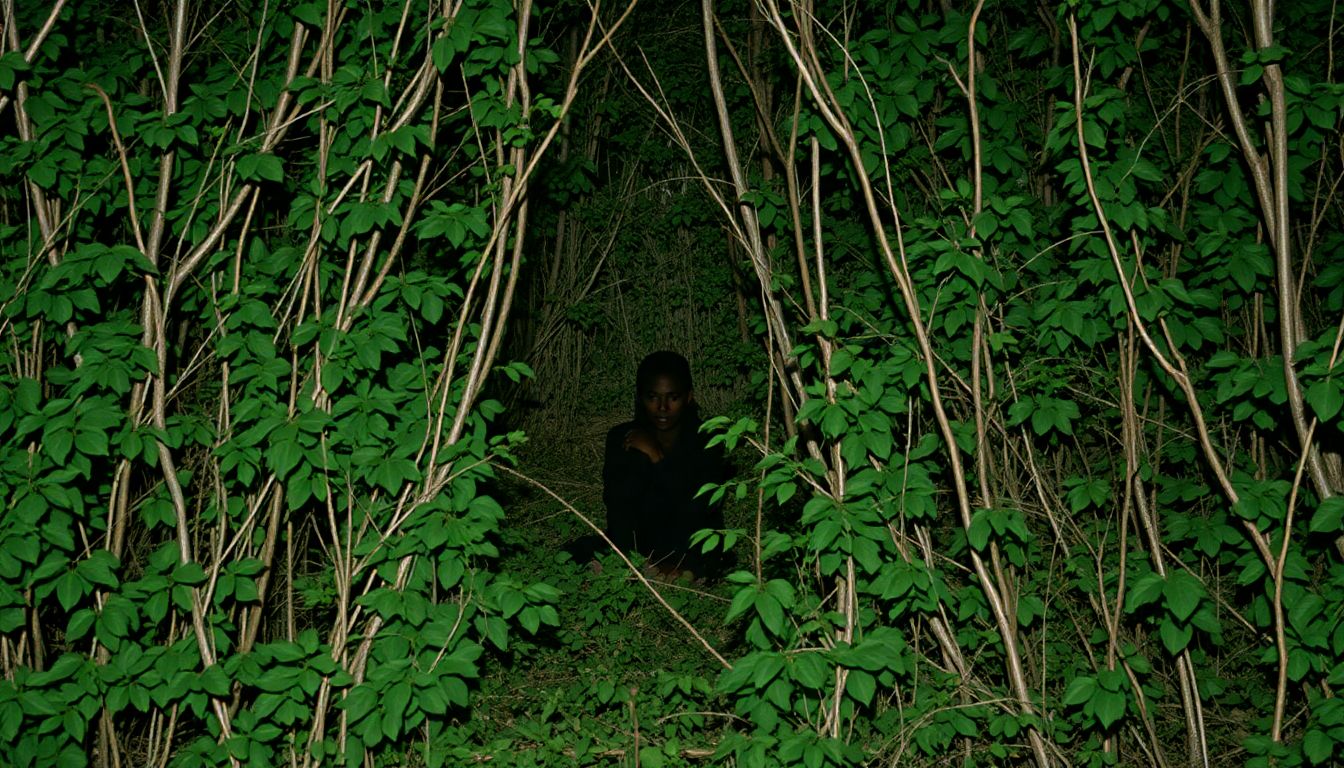
The Art of Stillness: Hiding in Plain Sight
In the grand ballet of life, sometimes the most effective move is to stand still. The art of stillness, when mastered, can be your secret weapon for remaining undetected, a skill as old as time itself, used by predators and prey alike. This subtle dance with immobility is not about mere inactivity, but a conscious decision to blend into the background, to become one with your surroundings.
Firstly, finding the right hiding spot is akin to finding the perfect frame for a painting. You want a place that breaks up your silhouette, making you less noticeable. Look for natural cover like trees, bushes, or rocks. The key is to choose a spot that doesn’t draw attention to itself, a place where you can become a chameleon, changing color to match your environment.
Once you’ve found your spot, it’s time to master the art of stillness. This is where patience becomes your ally. Remember, the world is a busy place, and movement catches the eye. By remaining still, you become just another part of the landscape, easily overlooked. But beware, stillness doesn’t mean rigidity. Small, slow movements can help maintain circulation and prevent stiffness, but they should be subtle, almost imperceptible.
To further break up your silhouette, use your environment to your advantage. If you’re in a forest, lean against a tree to merge your shape with its trunk. If you’re in an urban setting, use the angles of buildings or the shadows cast by fire escapes. The goal is to create a visual puzzle, making it difficult for the eye to discern where you end and your surroundings begin.
Lastly, remember that stillness is not about holding your breath until the danger passes. It’s about finding a rhythm, a harmony with your environment. It’s about becoming a part of the symphony of life, rather than a discordant note. And when the time is right, you can move again, fluid and graceful, like a fish swimming through water.
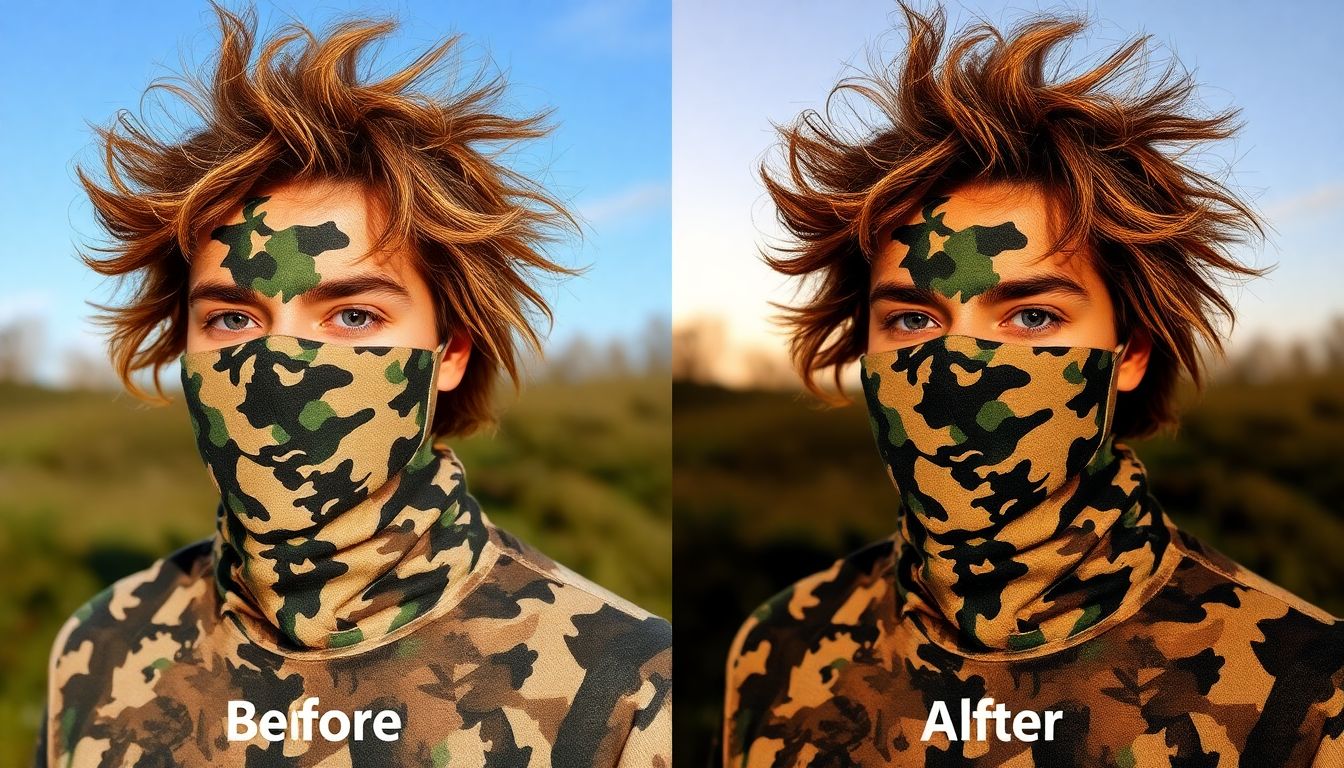
Adapting Your Camouflage: Changing with the Light and Season
In the grand theater of nature, light and season are the directors, constantly shifting the scene and demanding adaptability from all participants, including those who rely on camouflage for concealment. The effectiveness of your camouflage isn’t a static property; it’s a dynamic dance with the environment, and understanding how light and season affect it is key to mastering the art of blending in.
Light, the great revealer, can be both your ally and adversary in the game of hide and seek. The angle, intensity, and quality of light can dramatically alter the way your camouflage is perceived. In low light conditions, such as dawn or dusk, or in heavily shaded areas, colors tend to blend together, making it easier to hide. However, in bright, direct sunlight, details become more visible, and your camouflage pattern may stand out like a sore thumb. To adapt, consider using camouflage patterns that mimic the natural dappling of light in shaded areas, or opt for colors that blend well with the environment in bright light.
Seasons, too, play a significant role in the effectiveness of your camouflage. The changing foliage, snow cover, and even the color of the sky can make or break your concealment. In autumn, for instance, the vibrant reds and oranges of the leaves can clash with traditional green camouflage, making you stand out like a sore thumb. In winter, the stark contrast of snow against most camouflage patterns can make you as visible as a polar bear in a blizzard. The solution? Layer your camouflage strategy with seasonal considerations. In autumn, incorporate earthy tones and warm hues into your gear. In winter, use white or break up your silhouette with snow-camouflage patterns.
Remember, the goal of camouflage is not to become invisible, but to blend in with your surroundings just enough to avoid detection. It’s a constant process of adaptation, a dance with the light and the season. So, stay observant, stay adaptable, and stay one step ahead of the great revealer, the light.

Camouflage for Different Environments: From Desert to Snow
Adapting your camouflage to your surroundings is a crucial skill for anyone seeking to blend in with their environment. Let’s explore how to do this in various settings, from the scorching desert to the frosty snow, and the bustling urban jungle.
The desert, with its vast expanses of sand and rock, presents a unique challenge. Here, you’ll want to stick to earthy tones like beige, brown, and light gray. Avoid anything too bright or dark, as these can stand out starkly against the landscape. Remember, the key is to break up your outline, so consider using patterns that mimic the natural textures of the desert, such as rocks or sand dunes. Don’t forget to cover your gear as well; a desert-colored pack cover can make a significant difference.
Forests, with their dense greenery, require a different approach. Here, you’ll want to blend in with the foliage. Greens, browns, and dark greens are your friends. Consider using a ghillie suit, which is designed to mimic the appearance of leaves and branches, providing excellent camouflage in wooded areas. Also, remember to use face paint that matches your surroundings to avoid giving yourself away with a bright, shiny face.
Now, let’s talk about the snow. In a winter wonderland, you’ll want to go for whites, grays, and light blues. However, a common mistake is to use only white, which can make you stand out like a sore thumb. Instead, use a mix of these colors to create contrast and blend in with the varied textures of snow-covered landscapes. Also, consider using a snow camouflage cover for your gear to avoid leaving telltale tracks.
Finally, the urban environment. Here, the goal is to blend in, not stand out. You’ll want to use colors that match the typical clothing of the area, such as dark blues, blacks, and grays in a city setting. Avoid military-style clothing, as this can draw unwanted attention. Instead, opt for everyday clothing that you can adapt with accessories like a hoodie or a hat. Remember, the key in urban environments is to look like you belong.
In all these environments, it’s also crucial to consider your movement. Slow, deliberate movements can help you blend in, while sudden, jerky movements can draw attention. And always remember, the best camouflage is often not about what you wear, but how you use it.

The Psychology of Camouflage: Blending In Mentally
In the vast, unpredictable theater of life, the art of camouflage isn’t merely about blending into the physical landscape; it’s also about mastering the mental terrain. Imagine, if you will, a chameleon not just changing its skin color, but also its state of mind to match its environment. This is the psychology of camouflage, a subtle dance of adaptation that can mean the difference between standing out like a sore thumb and seamlessly blending in.
The first step in this mental camouflage is maintaining a calm and focused mindset, a state often referred to as ‘flow’ in psychology. This is not about suppressing emotions or ignoring your surroundings, but rather about being fully present and engaged with your environment. It’s about being like water, as the ancient martial arts philosophy goes, flowing around obstacles rather than crashing against them. To achieve this, practice mindfulness and deep breathing exercises. They can help you stay centered and responsive, rather than reactive.
Next, use your surroundings to your advantage. This isn’t about turning into a human chameleon, but about understanding and leveraging the psychology of your environment. For instance, in a crowded room, blend in by mirroring the body language and conversation topics of those around you. In a survival situation, use the environment to your advantage. If you’re lost in the woods, observe the direction of moss growth on trees, the position of the sun, or the flow of water to help navigate. If you’re in a dangerous situation, use your surroundings to create a makeshift shelter or weapon. The key is to not just see your environment, but to understand it, and use it to your advantage.
Remember, the goal of mental camouflage isn’t to become invisible, but to become unremarkable. It’s about being in the right place at the right time, with the right mindset, so you can respond effectively to whatever life throws your way. It’s about being like a fish in water, so comfortable and at ease that you can swim through life’s currents with grace and ease.
FAQ
What is the first step in creating DIY camouflage for survival situations?
How can I use natural materials to create camouflage?
- Break off small branches and twigs to create a makeshift ‘ghillie suit’ that can help break up your outline.
- Use mud or clay to darken your skin and clothing, helping you blend into shadows.
- Tear up leaves and grass to create a ‘paint’ that you can apply to your clothing and gear.
What are some stealth techniques to move silently through the wilderness?
- Walk slowly and deliberately, placing your feet carefully to avoid making noise.
- Avoid stepping on twigs and branches that could snap underfoot. Instead, step over them or move around them.
- Use natural cover, such as trees and bushes, to hide your movement.
- Breathe slowly and deeply to maintain your calm and focus.
- Listen for any sounds that might indicate danger, such as animal movements or human voices.
How can I use my surroundings to create a makeshift shelter for concealment?
- Find a depression in the ground or a low-hanging branch that you can use to create a simple lean-to shelter.
- Use available materials, such as branches, leaves, and moss, to camouflage your shelter and blend it into the surroundings.
- Position your shelter in a way that takes advantage of natural cover, such as trees or bushes.
- Consider using a poncho or tarp to create a makeshift tent, which can be easily camouflaged with natural materials.
What are some common mistakes to avoid when trying to create DIY camouflage?
- Using bright or contrasting colors that stand out against your environment.
- Focusing solely on your clothing and neglecting to camouflage your gear, such as backpacks or weapons.
- Applying camouflage in large, solid patches, rather than breaking it up into small, irregular patterns.
- Not considering the time of day and how the lighting might affect your camouflage.
- Moving too quickly or making loud noises, which can draw attention to your position.
How can I effectively camouflage my gear and equipment?
- Use natural materials, such as leaves, mud, or grass, to cover your gear and break up its outline.
- Wrap your gear in camouflage netting or cloth to help it blend in with the surroundings.
- Remove any reflective surfaces, such as shiny metal or logos, that could give away your position.
- Consider using a ghillie suit or other form of camouflage clothing to help break up your outline and mimic the environment.
- Store your gear in a way that minimizes its visibility, such as under a bush or in a depression in the ground.
What are some advanced stealth techniques for moving through dense vegetation?
- Use a ‘snake-like’ movement, where you move your body in a wave-like motion, keeping your center of gravity low and your movements slow and deliberate.
- Use your hands to part the vegetation in front of you, rather than pushing through it, to minimize noise and disturbance.
- Step over obstacles, rather than climbing over them, to avoid making noise and disturbing the vegetation.
- Listen for any sounds that might indicate danger, such as animal movements or human voices, and adjust your movement accordingly.
- Consider using a ‘shadow’ or ‘mirror’ technique, where you move in the shadow of a larger object, such as a tree, to help you blend in with the surroundings.
How can I effectively camouflage myself in urban environments?
- Observe the colors and patterns of the buildings and surroundings, and try to mimic them with your clothing and gear.
- Use graffiti or other urban art to help break up your outline and blend in with the environment.
- Position yourself in areas that provide natural cover, such as alleys, doorways, or behind vehicles.
- Consider using a ‘broken’ pattern of camouflage, where you use different colors and patterns to mimic the varied surfaces of an urban environment.
- Move slowly and deliberately, avoiding sudden movements that could draw attention to your position.
What are some creative ways to use everyday items for DIY camouflage?
- Use a black trash bag as a makeshift poncho or tent, which can be easily camouflaged with natural materials.
- Wrap duct tape around your gear or clothing to help break up its outline and mimic the environment.
- Use a sheet or blanket to create a makeshift ghillie suit, which can be easily camouflaged with natural materials.
- Use a face mask or balaclava to cover your skin and help you blend in with the surroundings.
- Use a piece of cardboard or foam board to create a makeshift ‘cutout’ that can help you blend in with the environment.



